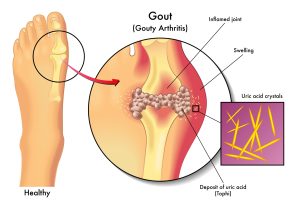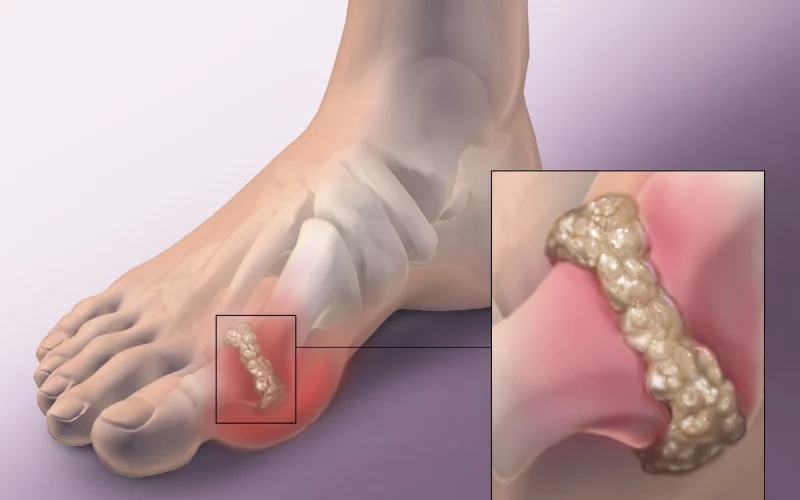Unveiling the Complexity of Gout
Gout, a form of arthritis, is a perplexing condition that can affect anyone. Characterized by sudden, intense attacks of pain, swelling, redness, and tenderness, it most commonly targets the big toe. Imagine waking up in the middle of the night with the sensation that your big toe is on fire – this is the hallmark of a gout attack.
A Closer Look
- Intense Joint Pain: The primary feature of gout is its sudden and excruciating joint pain. While the big toe is the usual suspect, it can strike any joint in the body. The pain tends to peak within the first four to 12 hours after onset, making even the weight of a bedsheet intolerable.
- Lingering Discomfort: After the peak pain subsides, gout leaves behind joint discomfort that can persist for days to weeks. Subsequent attacks often last longer and may affect more joints, leading to a cumulative impact on one’s overall well-being.
- Inflammation and Redness: The affected joint or joints become visibly swollen, tender, warm, and red. These signs indicate an inflammatory response, a characteristic feature of gout. The inflammation contributes to the pain and discomfort associated with the condition.
- Limited Range of Motion: As gout progresses, it may impede normal joint movement. This limitation in the range of motion can gradually worsen over time, affecting the affected joints’ flexibility and functionality.

Managing Gout Symptoms
While gout symptoms may come and go, adopting proactive measures can significantly contribute to symptom management and flare prevention. One valuable resource is the “Mayo Clinic Guide to Arthritis,” providing comprehensive insights into understanding and managing arthritis conditions, including gout.
In addition to seeking expert guidance, individuals with gout can take several steps to manage their symptoms:
- Lifestyle Modifications: Making changes in diet, staying hydrated, and maintaining a healthy weight can have a positive impact on gout symptoms. Avoiding foods high in purines, such as red meat and certain seafood, may help prevent flare-ups.
- Medications: Your healthcare provider may prescribe medications to alleviate pain during acute attacks and prevent future ones. Medications may include nonsteroidal anti-inflammatory drugs (NSAIDs), colchicine, or urate-lowering drugs.
- Regular Exercise: Engaging in low-impact exercises, such as walking or swimming, can help maintain joint function and reduce the risk of recurrent gout attacks.
A User-Friendly Approach to Gout Awareness
Understanding gout doesn’t have to be complex. Here’s a simplified breakdown of key points:
- What is Gout? Gout is a type of arthritis known for sudden, intense joint pain, commonly affecting the big toe.
- Symptoms: Watch out for intense pain, swelling, redness, and tenderness in joints, especially during the night.
- Management: Lifestyle changes, medications, and regular exercise can help manage symptoms. The “Mayo Clinic Guide to Arthritis” is a valuable resource for in-depth information.
- When to See a Doctor: Seek medical attention if you experience sudden, severe joint pain, or if you notice a fever with hot and inflamed joints.
By simplifying the information and emphasizing the user-friendly approach to managing gout, individuals can navigate their journey with greater ease, making informed decisions for their health and well-being. want to explore more treatments for different (gallstones Treatment)
| Aspect | Gout | Arthritis |
|---|---|---|
| Definition | Form of arthritis causing sudden attacks | General term for joint inflammation |
| Affected Joints | Primarily big toe; others like ankles, knees, elbows, wrists, fingers | Varied joints depending on type |
| Onset of Pain | Sudden and intense, often at night | Gradual onset with varying severity |
| Duration of Discomfort | Lasts from hours to weeks | Varies based on arthritis type |
| Inflammation | Swollen, tender, warm, and red joints | Joint inflammation is a common feature |
| Range of Motion | Limited as gout progresses | Depends on arthritis type and severity |
Understanding the nuances helps in distinguishing gout from general arthritis, aiding in effective management.
When to Seek Medical Attention
Prompt medical attention is crucial for effective gout management. If you experience sudden, intense pain in a joint, it’s advisable to consult your doctor promptly. Untreated gout can lead to worsening pain and potential joint damage, impacting your overall quality of life.
Moreover, if you notice a fever accompanying hot and inflamed joints, it could be a sign of infection. In such cases, seeking immediate medical care is imperative to address the underlying issue and prevent further complications.

Conclusion
In conclusion, unraveling the complexities of gout reveals a condition characterized by sudden, intense joint pain, often targeting the big toe. Understanding the symptoms, such as swelling, redness, and limited range of motion, is crucial for effective management. The journey towards managing gout involves a holistic approach, from lifestyle modifications and medications to regular exercise.












